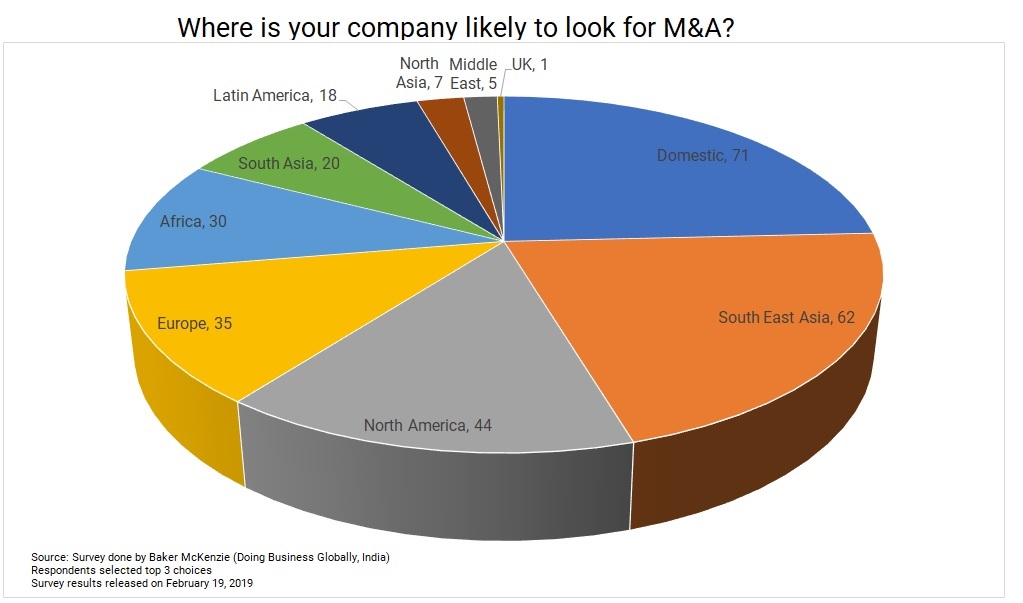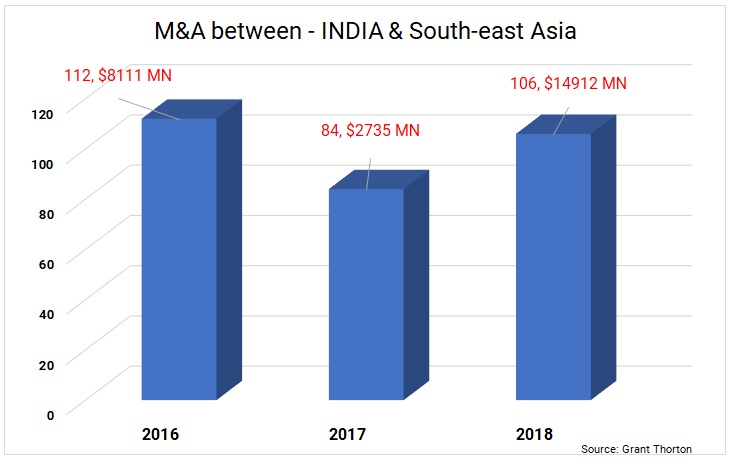Indian companies are increasingly looking at South East Asian countries for business and mergers and acquisitions (M&As) because there is a good strategic and cultural fit with companies in the region. Indian companies in sectors such as healthcare, consumer and industrials have done M&As with counterparts in countries such as Malaysia, Indonesia and Thailand.
Smart Indian entrepreneurs are increasingly looking at South East Asia for its sizeable collective market, greater ease of doing business, and large unmet demand for information technology expertise.
Moreover, barring Singapore, education in technology and engineering is considerably lacking in South East Asia and that is where Indian entrepreneurs are gradually making a mark in the region.
The M&As deals between Indian and South East Asia countries grew from $8.1 billion in 2016 to $14.9 billion in 2018, according to data from Grant Thornton. Moreover, a survey done by Baker McKenzie on 100 C-Suite Indian business leaders shows that deal making will continue to increase, with 7 in 10 Indian business leaders expecting a significant increase in M&A in their industry. In terms of where Indian business are looking to acquire and invest, domestic targets still top the list, but South East Asia now runs a close second.
Growth drives M&A
In the past, the US was the number one destination for Indian companies looking for M&As and other investment opportunities outside of Asia. Also, the UK is no longer a preferred investment destination, because of looming Brexit fears and slowing economy. However, intra-Asian deal sizes are still usually smaller than those in Western markets.
Rapid economic growth in South East Asia is attracting a lot of global capital and the M&A route is emerging as a popular way to enter the market. In fact, M&As can offer foreign companies’ smoother entry and local companies can help disentangle the complexities. The region has a population of around 650 million and a combined GDP of $2.7 trillion. The region is also inter-connected and consists of a rising young population which drives consumption growth. A Bain research shows that South East Asia’s investment ecosystem is entering a new phase of growth and by 2024, the region will give rise to at least 10 new companies with a market value of more than $1 billion each.
Rise in global M&A in South East Asia
In the past few years, South East Asia has seen an unprecedented spate of M&As driven mainly by Chinese companies. The most favoured industries are banking, retail, beverage and packaged food primarily because they are highly fragmented. The total value of M&A in the region touched a record high of $89 billion-dollar last year and Chinese buyers are eager to snap up companies in South East Asia. Nearly, 70% of Chinese investment was targeted at logistics and transportation. Technology has become South East Asia’s leading investment sector, with 40% of the total deal count in 2017 (break-up data of 2018 is still not available).

Country-wise, Indonesia remains a potential country for acquisitions. Indonesia, South-East Asia’s largest economy, has emerged as an unlikely source of big-ticket M&A financings after being dormant for many years. In 2018, there were around 45 deals worth $12 billion compared to $10 billion in 2017. As part of an economic stimulus package, the Indonesian government has revised the negative list of investment and opened more than 30 businesses previously restricted to overseas investment. The move to relax the norms was done to attract foreign direct investment in the country. As a result, sectors that have opened up to FDI are oil and gas offshore drilling, pharmaceuticals, telecommunications network carriers and construction equipment.
Though Singapore remains South East Asia’s investment hub, vibrant start-up ecosystems are emerging across the region. In Malaysia, transactions are generally spread across industries and the notable transactions are in the oil and gas sectors particularly in upstream investment. Domestic oil and gas players are keen to consolidate their position not just regionally but also on a global level.
Venture capital (VC) and private equity (PE) investment in South East Asia, too are rising. Though VC and PE investment data for 2018 is still not available, a study done by Bain and capital in 2017 shows that the number of recorded VC deals rose to 524, four times the level of 2012 and private equity deal value rose 75% to $15 billion.
India’s footprint in South East Asia
Indian companies have been actively looking at mining assets in Indonesia. In 2016, SSEL Mining & Industries, the unlisted unit of the Aditya Birla Group, acquired a mining company in Indonesia for $180m in one of the biggest deals in the mining sector. At the time of acquisition, the company had the capacity to mine about five to 10 million tonnes of coal a year. Similarly, Tata Steel and JSW Steel, too had made Indonesia as one of their growth markets.

Prominent Indian industrial groups such as Tata Power, Reliance, Adani, L&T, GMR, GVK, Trimex, Videocon and Punj Lloyd have made investments in infrastructure, power, steel and automotive sectors in Indonesia. IT companies such as TCS, Tech Mahindra, HCL and Altruist have set up business units in Indonesia. Recently, Lulu Group opened a new hypermarket in Jakarta after acquiring a local real estate company. US-based aluminium producer Novelis, the subsidiary of India’s Hindalco Industries and conglomerate Aditya Birla Group, is raising US$2.275bn in loans for its acquisition of rolled aluminium products supplier Aleris.
Indian companies form the single largest foreign business community in Singapore as the country offers an enabling investment environment. In fact, the signing of the India-Singapore Comprehensive Economic Cooperation Agreement (CECA) in 2005 helped both countries strengthen their trade links. Given Singapore’s location and the growing Asia-Pacific market, Indian companies are using Singapore as a springboard to tap on growth opportunities in this region. Singapore is traditionally an IT and telecom hub, with good infrastructure such as data centers.
Indian companies such as Tata Communications, TCS, Mahindra Satyam/Tech Mahindra, Infosys and Wipro have established significant presence in Singapore. Leading Indian companies such as Punj Lloyd and Quest Global have set up their regional operations in Singapore to tap the growth potential in Asia in the infrastructure and engineering, procurement and construction (EPC) sector. For Indian entrepreneurs, Singapore remains South East Asia’s main hub as after launching in the island nation, they can then get to markets in Malaysia, Indonesia, Philippines, etc.
In Malaysia, Adani Ports and Special Economic Zone (APSEZ) has entered into an agreement with MMC Ports to set up a container port in Carey Island in Malaysia. In South East Asia, both consumer and enterprise products are in huge demand and even the retail sector is expanding rapidly. Jungle Ventures, a venture firm that focuses solely on startups, has invested in 23 companies across the region over the past four years, including crowdfunding platform Milaap and mobile payments company Pokkt.
Challenges in South East Asia
While M&As may be an attractive option in South East Asia, the region’s regulatory environment is very complex, bureaucracy is very inconsistent and there are multiple restrictions on foreign ownership. As a result, achieving strong returns on investment is not always easy for foreign investors. Finding the right partner is very crucial. Partnering with reputable local companies and ensuring alignment across long-term growth are key.
However, things are changing a bit these days. In Indonesia, there was a major shift of M&A deals dominated by the technology sector during 2017, in contrast to 2016 when the mining sector was the main attraction. Political support by the new government has generated renewed optimism about Indonesia’s potential growth and there is substantial untapped potential for M&A in the country because of rising middle class.
Conclusion
To make M&As work, especially in South East Asia, Indian companies must undertake a comprehensive due diligence exercise. In addition to due diligence, the management must engage in a higher level of scrutiny on sellers and co-investors. Indian management must focus more on corporate compliance by the target, particularly on corruption and bribery issues. They must also understand the efficiency of the group tax structure, foreign currency fluctuations and the remittance of money outside the region to minimize the risk of repatriated profits.





Add comment